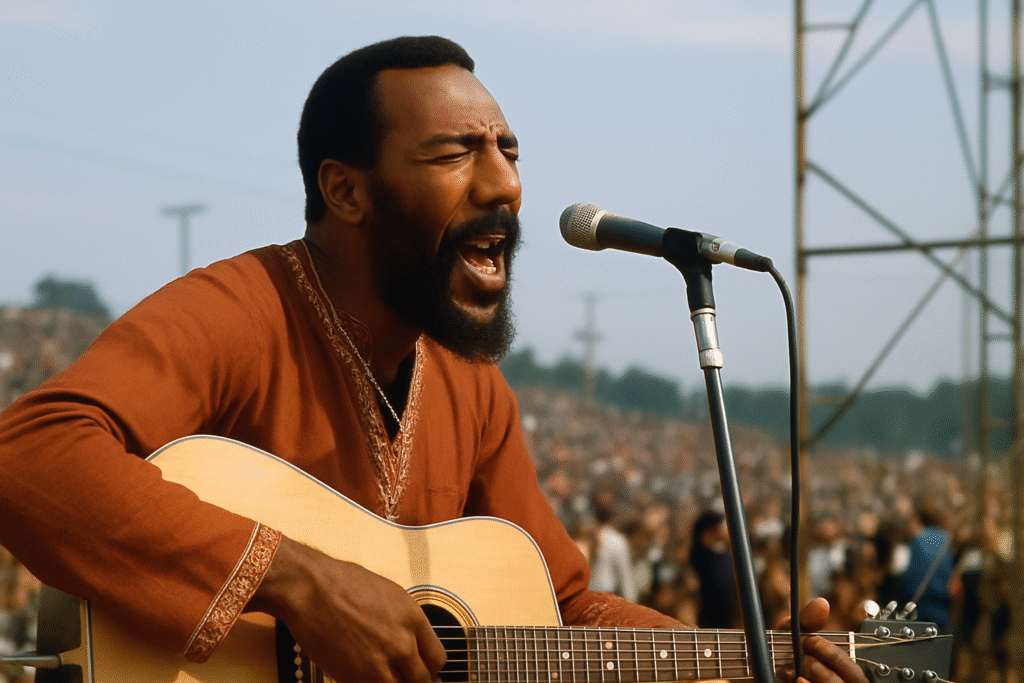
AI-generated image for illustrative purposes.
The year 1969 was a boiling cauldron of contradictions. On one side, the United States was sinking deeper into the Vietnam War, drafting thousands of young men to fight in a senseless conflict. On the other, a generation blossomed, believing in peace, love, and music as transformative forces. The hippie movement was no longer just a fleeting trend — it had become a collective cry against violence, conservatism, and suffocating consumerism. Out of that climate came the idea of Woodstock.
Between August 15 and 18, 1969, a farm in the small town of Bethel, upstate New York, welcomed half a million young people searching for something unforgettable. What was meant to be just another festival became the ultimate symbol of an era.
Who Organized Woodstock
Four young dreamers dared to think big: Michael Lang, John Roberts, Joel Rosenman, and Artie Kornfeld. Lang had already organized the 1968 Miami Pop Festival, a kind of test run. Roberts, a wealthy heir, brought the money. Rosenman, a lawyer and amateur musician, added a business vision. Kornfeld, then an executive at Capitol Records, connected the project to the music industry.
None of them had the experience to handle hundreds of thousands of people, but their naivety and boldness became fuel. The original plan was for 50,000 paying attendees. Instead, in a matter of days, clogged roads, broken fences, and nearly half a million people flooded the site.
Chaos Before the First Note
Even before a single chord was played, the festival had spiraled out of control. Traffic was backed up for miles, many artists couldn’t make it in time and had to be flown in by helicopter. Food was scarce, bathrooms were insufficient, and the sound system was poorly adjusted.
Yet, it wasn’t violent chaos. Quite the opposite. Neighbors donated milk and sandwiches, doctors volunteered, and young people helped each other. For the first time, it seemed possible — even if just for a few days — to live the dream of a community built on solidarity.
Richie Havens: Destiny’s Accidental Choice
On the afternoon of August 15, with the schedule collapsing, organizers turned to whoever was ready. That’s how Richie Havens, a relatively unknown New York folk singer, was pushed onto the stage. He wasn’t supposed to be the grand opener, but fate placed him in front of hundreds of thousands of music-hungry souls.
Who Was Richie Havens Before Woodstock
Born in Brooklyn, Havens carved out a modest career in the Greenwich Village coffeehouse circuit, the same crucible that birthed Bob Dylan and Joan Baez. His deep, soulful voice, combined with a percussive guitar style, made him stand out in the folk scene, but he was still a niche figure. He had a few albums out, a solid reputation in the underground, but nothing close to stardom.
What Havens did have, though, was something money couldn’t buy: authenticity. And Woodstock would turn that into historical force.
“Freedom”: The Anthem Born at Woodstock
Havens began his set with his own material, but soon realized he had to stall for time — the next acts were stuck in traffic. He repeated songs, stretched out arrangements, improvised verses. The audience, entranced, didn’t mind.
Finally, nearly exhausted, he started a simple, almost tribal rhythm and chanted: “Freedom, freedom, freedom…” The base was the old gospel Motherless Child, but in that moment he transformed it into something new. The cry for freedom became the distilled essence of the generation standing in that muddy field.
Captured in the official documentary, the scene became one of Woodstock’s defining images. Richie Havens, who had never faced such a massive audience, had just delivered the festival’s first legendary moment.
Rough Sound, Untouched Magic
The sound system, still unbalanced, meant that some in the far reaches couldn’t hear well. But that hardly mattered. What reached the half million gathered wasn’t just music — it was collective vibration, a ritual where everyone felt part of something bigger.
The Immediate Impact on Richie Havens
When Havens walked offstage, he was no longer an obscure folkie. He had become Woodstock’s first legend. His career gained international reach, and Freedom instantly turned into an anthem of the counterculture, tied to civil rights and antiwar resistance.
Woodstock, which seemed doomed to fail before it even started, had found its voice. From that moment on, every performance would be loaded with symbolism. This wasn’t just a festival — it was the living portrait of a utopia.
Woodstock Begins as Myth
What could have been a logistical disaster transformed into legend. Richie Havens, chosen in desperation, ignited the festival’s eternal spark. That muddy, dream-filled field in Bethel became the heartbeat of a generation.
Woodstock had begun — and rock would never be the same.
Burning Questions
Who really created Woodstock?
Four young men: Michael Lang, Artie Kornfeld, John Roberts, and Joel Rosenman. They had no mega-event experience, but with luck and boldness, they pulled off the biggest festival in history.
Did Richie Havens know he’d open the festival?
Not at all. He was thrown onstage because other acts were stuck in traffic.
Was “Freedom” written on the spot?
Yes. It was improvised from Motherless Child and became the anthem of a generation.
Did the poor sound ruin the opening?
No. Emotion triumphed over technical flaws. Havens’ improvisation turned into pure poetry.
Did Havens become a star after Woodstock?
He never reached the heights of Hendrix or Joplin, but his performance etched him into rock history.
— Lena Blaze, Rock Vaults
